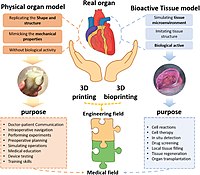
Photo from wikipedia
Escalating cases of organ shortage and donor scarcity worldwide are alarming reminders of the need for alternatives to allograft tissues. Within the last three decades, research efforts in the field… Click to show full abstract
Escalating cases of organ shortage and donor scarcity worldwide are alarming reminders of the need for alternatives to allograft tissues. Within the last three decades, research efforts in the field of regenerative medicine and tissue engineering continue to address the unmet need for artificial tissues and organs for transplant. Work in the field has evolved to create what we consider a new field, Regenerative Engineering, defined as the Convergence of advanced materials science, stem cell science, physics, developmental biology and clinical translation towards the regeneration of complex tissues and organ systems. Included in the regenerative engineering paradigm is advanced manufacturing. Three-dimensional (3D) bioprinting is a promising and innovative biofabrication strategy to precisely position biologics, including living cells and extracellular matrix (ECM) components, in the prescribed 3D hierarchal organization to create artificial multi-cellular tissues/organs. In this review, we outline recent progress in several bioprinting technologies used to engineer scaffolds with requisite mechanical, structural, and biological complexity. We examine the process parameters affecting bioprinting and bioink-biomaterials and review notable studies on bioprinted skin, cardiac, bone, cartilage, liver, lung, neural, and pancreatic tissue. We also focus on other 3D bioprinting application areas including cancer research, drug testing, high-throughput screening (HTS), and organ-on-a-chip models. We also highlight the current challenges associated with the clinical translation of 3D bioprinting and conclude with the future perspective of bioprinting technology.
Journal Title: Biomaterials
Year Published: 2019
Link to full text (if available)
Share on Social Media: Sign Up to like & get
recommendations!